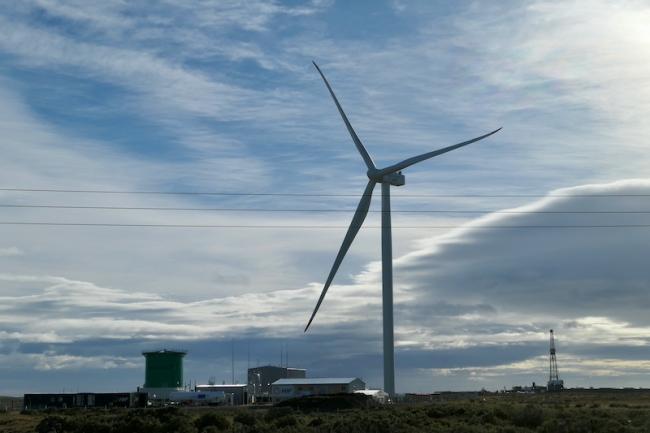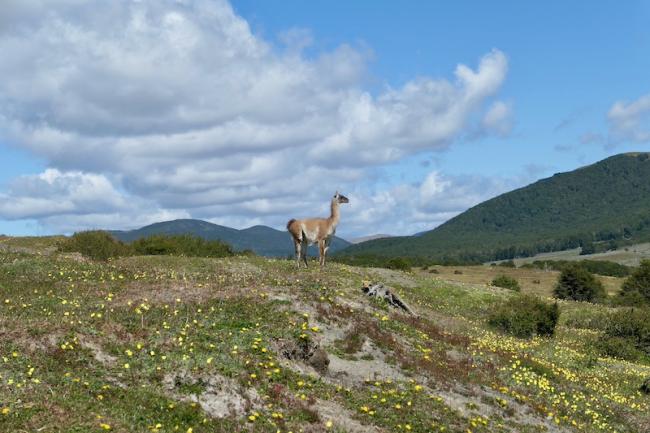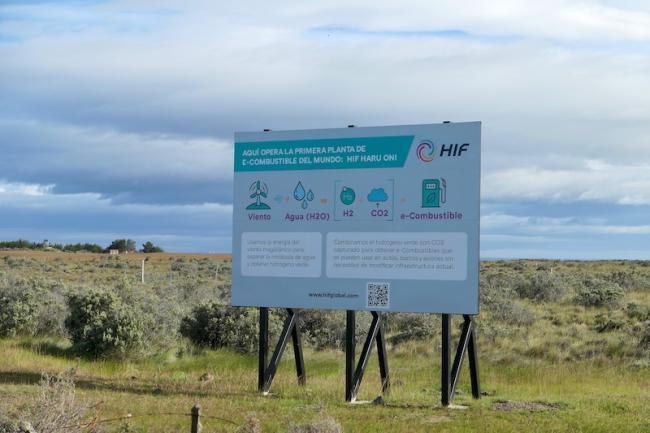
“The ranching lifestyle may be ending.” That’s Michael Robertson Shaw’s fear as Tierra del Fuego’s ferocious winds, once considered a nuisance, are poised to transform Chile into a world leader in green hydrogen production.
With family roots dating back to the early 20th century, Robertson’s Estancia Doménica is located along the northwest coast of the island of Tierra del Fuego, 10 kilometers (6 miles) from the Straits of Magellan. It lies adjacent to the British-based Transitional Energy Group’s (TEG) proposed Gente Grande wind farm.

Robertson is used to tending livestock amidst the herds of guanacos and wild horses that roam the Patagonian steppe. But in just a few years, a series of megaprojects may replace the bleating of sheep with the hum of thousands of 120-meter (390 feet) wind turbines and high-tech energy installations.
Sheep ranching, Tierra del Fuego’s main land use, is already economically tenuous due to labor shortages, drought, and a volatile wool market. Now, most landowners in the designated project zones are collaborating with TEG. Those living in cities like Santiago and Buenos Aires see ranching merely as an investment and are eager to collect what Robertson estimates will be “10, 20 times what they earned with sheep.” He predicts a widespread collapse of his beloved ranching culture.
But sheep aren’t the only animals under threat.
A few hours’ drive from Robertson’s ranch on the island’s north shore lies the vast wind-blasted mudflats of Bahía Lomas, a hugely important site for migratory birds in the southern hemisphere. Biologist Carmen Espoz of the Bahía Lomas Center shares Robertson’s concern about local livelihoods, but she also urges people to look to the sky and ocean.
“I am not against green hydrogen,” said Espoz. “I am not because we need [low carbon energy].” However, she stresses the potential costs for aquatic life, which is vulnerable since the desalination required by the production process demands large amounts of fresh water. They plan to dump the byproduct—a concentrated salty brine—back into the ocean.
For birds, wind turbines potentially represent thousands of collisions per year.
“Bahía Lomas is the place of the Magellanic plover, or “Chorlo de Magallanes," which is a species that is in danger of extinction,” Espoz said. If green hydrogen projects are to go forward, she argued, the public should be clear-eyed about the possible consequences. “If we are not willing to give up our [destructive] way of life on a global scale, then whom do we sacrifice?”
Celebrating a Green Energy Boom
With wind gusts often topping 100 kilometers per hour, walking upright in Patagonia can be tough. Instead of complaints, however, many champion the region’s new natural resource of choice.
Wind power—"practically free" according to local mechanical engineer Michael Segura Cortez—and a process called electrolysis may allow Southern Chile to generate as much as 13 percent of global green hydrogen output. With that in mind, the country has commissioned 49 electrolysis projects.
Thanks to sweeping political and industry support, Chile’s president and Patagonia native Gabriel Boric signed a protocol that encourages public-private alliances related to green hydrogen. The deal is already bearing fruit: Chile’s National Petroleum Company (ENAP) recently announced a collaboration with the German company Neuman & Esser on a new production facility.
The European Union, a dual investor and buyer, is relying heavily on Chile’s energy revolution to produce the synthetic fuel it needs to become carbon neutral by 2050. Energy companies like HIF Global celebrate their Patagonia projects as “fueling our world with renewable energy.”

Touting both environmental and development benefits, the World Bank is also on board, approving a $150 million loan last year to finance Chilean green hydrogen. European Commission President Ursula von der Leyen pitches the new industry as a win for both regions, creating jobs in Chile and boosting exports to Europe.
Highlighting job creation is a smart strategy to build Patagonian support. José Gabriel Parada, mayor of Tierra del Fuego’s town of Porvenir, is eager for an economic boom to help his community move beyond spotty cell coverage and poor services.
Despite a fish processing plant, an abattoir, and modest tourism operations, Porvenir’s economy is precarious. Many young people are leaving the island. Parada sees companies like HNH Energy as the solution. Last month, the Austrian-based company submitted an impact study for a nearby project on the mainland. Totaling $11 billion, with an estimated July 2026 start date, it is the largest proposal ever evaluated by the government’s Environmental Assessment System.
A major selling point for proponents of green hydrogen in Patagonia is that installing and maintaining wind turbines, new ports, chemical plants, roads, housing, and goods and services for workers promises many new jobs.
Efforts to prepare the workforce are in high gear. Last May, Porvenir’s Center for Technical Training (CFT) and TEG agreed to collaborate on training regional workers in jobs supporting the green hydrogen industry. As far as energy companies are concerned, the projects are full steam ahead.
A Possible Green Sacrifice Zone
When asked about possible negative impacts connected to green hydrogen, TEG official Enrique Rebolledo Toro said, “Local people are much more concerned that an industry leads to work and leads to development.” But Nicolás Jara, a ranger at Tierra del Fuego’s 300,000-hectare Karukinka Park, disagreed: “It's not a boom [for us] because the money goes abroad.”
Political scientist Robert Lindner shares Jara’s concern. After studying the Global North’s investment in green hydrogen development in the Global South, he found that such partnerships must avoid “being dominated by the economic priorities of Northern partners or captured by local elites uninterested in changing the status quo.”

For many, this sounds eerily familiar. After the genocide of Patagonia’s Indigenous people began in the early 1800s, sheep ranching expanded, bringing wealth to landowners supported by low-wage laborers from central Chile. Southernmost Chile has a long history of foreign investment in extractive industries—including oil and gas, livestock production, logging, and peat bog mining—resulting in problems ranging from pollution and deforestation to land dispossession and poor working conditions.
These wealth inequalities persist today. Recent economic booms, such as salmon farming and even tourism, have largely benefitted outsiders. The specialized nature of green hydrogen work means that the best-paying jobs often require workers from outside the region. Jara worries that this will result in a form of neocolonization in which the people who benefit financially, socially, and politically are not from Patagonia.
For Tierra del Fuego’s residents and environment the stakes are high. Unless benefits are shared equitably, the island and other sites in Patagonia risk becoming green sacrifice zones—areas often in the Global South where underprivileged communities are negatively affected “by the sourcing, transportation, installation, and operation of solutions for powering low-carbon transitions.”
Growing Unease
In addition to following Chile’s environmental assessment process, energy companies must adhere to guidelines outlined by the Escazú Agreement. Ratified by 16 Latin American countries, with Chile joining in 2022, the agreement promotes environmental justice. Instead of identifying specific outcomes, it emphasizes processes, such as timely information sharing and the inclusion of all local stakeholders in decision-making.
In response, energy companies hold public forums to present project details and answer questions. Ideally, collaboration between communities, government, and industry mitigates possible risks and promotes benefit sharing. Yet, while companies say they are committed to the Escazú Agreement and to transparency, industry websites present only cursory information. Dozens of community members claimed that the public forums they attended were perfunctory and failed to address specific concerns.
Last January, at an HNH Energy forum in Punta Arenas, HNH representatives were asked how the company would manage the disposal of the brine left over from desalination. They responded that dumping it into the ocean was safe. When pressed for studies to support their claim, they said they didn’t have them.
Espoz suggested that industry often obscures the context of the projects, leading to misrepresentations of their scope and impact. For example, while an individual project like Faro del Sur may only have 64 wind turbines, the cumulative number of turbines linked to green hydrogen in southern Chile may approach 3,000 by 2027 and cover 150,000 hectares.
Just weeks after speaking with TEG representative Rebolledo last January, controversy erupted. He was appointed as southern Chile’s Minister of the Environment, requiring him to oversee environmental policy, including matters associated with green hydrogen. Prensa Austral reported that over 20 community organizations demanded that Rebolledo’s appointment be “immediately revoke[d].” They cited a lack of transparency about his work with TEG and concerns about industry-government ties, claiming that his appointment “mortgages all legitimacy and impartiality, which is indispensable for a state authority with respect to its environmental policy.”
If government representatives, industry leaders, and international institutions like the World Bank are to be believed, Patagonia may be part of the perfect climate solution. But a growing number of local voices are not so sure.
In coming years, Chile’s energy revolution may spark a new, greener world, but risks throwing salt in the wound of the region’s painful past.
Peter Klepeis is Professor of Geography at Colgate University. He studies nature-society relationships and environmental history.
Keith Klepeis is Professor of Geography and Geosciences at the University of Vermont. He has researched the geology of Patagonia for over 30 years.
Gabriela Mora-Klepeis is Senior Research Technician in the Department of Geography and Geosciences at the University of Vermont and studies the geology of Mexico.
Jorge López Maldonado is a Técnico Forestal, expert in Geographic Information Systems, and consultant in Punta Arenas, Chile.
Editor's Note: This article was updated to correct the name of the Magellanic plover, or “Chorlo de Magallanes.”

